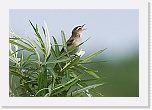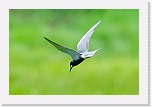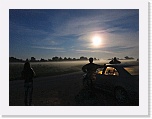<<- Main site
 Rusnen saari Liettuassa 12. - 15. 6. 2011
Rusnen saari Liettuassa 12. - 15. 6. 2011
Koska majoitusvarauksemme Rusnella alkoi vasta seuraavana päivänä, päätimme tutkia Meteliain lunnonsuojelualuetta (Meteli? regioninis parkas) Etelä-Liettuassa. Sielläkin on useita järviä, mutta lintutorneja harvassa. Yhden järven rantaruovikoissa onnistuimme kuitenkin kuvaamaan rastaskerttusia. Myös sorsalintuja näkyi järvellä. Tuuli voimakkaasti ja siksi lintujen tarkkailu oli hankalaa. Meteliai on kuitenkin varteenotettava vierailukohde.
Tien varsilla tarjottiin turisteille majoitusta. Kokeilimme yhtä, mutta se ei oikein miellyttänyt. Kun olimme jo poistumassa, kertoi omistajapariskunta, että heillä olisi pieni hotelli myös Marijampolen kaupungissa, jonne oli muutamia kymmeniä kilometrejä. Vähän epäröimme mutta kun hinta oli hyvin edullinen niin kysyimme kuinka sinne löytäisimme. Isäntä kertoi, että heidän poika tulee tiettyyn paikkaan kaupungin ulkopuolella vastaan ja opastaa meidät perille. Maksun voisimme jättää aamulla huoneen pöydälle ja laittaa avaimen postilaatikkoon.
Näin sovittiin tehtäväksi. Paikka osoittautui jonkinlaisen korjauspajan toimistoksi, jossa oli pieni keittiö, saniteettitilat ja erillisessä huoneessa yöpyjille sängyt. Hyvä siellä oli yö viettää. Sovitun muutan euron maksun jätimme sopimuksen mukaan pöydälle ja jatkoimme aamulla matkaa Rusnea kohti.
Rusne on Kuurinlahden rannalla. Saari muodostuu Nemunas joen deltassa joen eri haarojen väliin. Aikaisemmin jokakeväinen tulva on peittänyt suuren osan saaresta ja houkuttelut paikalle valtaisat lintumäärät. Nykyään joen penkkoja on kasvatettu ja tulvat ovat pienempiä. Samalla lintujen määrät ovat vähentyneet. Lintuja kuitenkin löytyy, mutta vähemmän. Luonnonsuojeluväki haluaisi ennallistaa oloja mutta paikallisväestö on sitä vastaan. Suojelu ei kuulemma kiinnosta ja rahaa siihen ei ole. Lintuja ajatellen Rusne on ilmeisesti nykyisin vain varjo entisistä mahtiajoista.
Paikallinen ornitologi järjesti yhtenä yönä ruisrääkkien laskennan. Nella kävi retkellä mukana. Mukana oli myös saksalainen pariskunta. Ajettiin autolla eri paikkoihin ja jokainen kirjasi itsenäisesti arvion kuulemiensa ruisrääkkien lukumääristä. Kolmelta aamuyöstä lopetettiin.
Olimme varanneet huoneen ivile Skirkevi?ienen kesäasunnosta Pakalne-joen rannalta (http://www.siluteinfo.lt/index.php/pageid/746/productpage/1/productid/424). Se oli hyvä valinta. Zivilen äiti, eläkkeellä oleva lääkäri, hoitaa paikkaa ja siellä on erittäin miellyttävä oleskella. Paikkaa voi lämpimästi suositella kaikille.
 Valokuvia
Valokuvia




 Rusne Island on Lithuania 12. - 15. June 2011
Rusne Island on Lithuania 12. - 15. June 2011
Because of our accommodation reservation in Rusne just began during the following day, we decided to study Meteliain natural park (Meteliai regioninis parkas) in South Lithuania. There are also several lakes there but bird towers in few. In the shore cane-grass of one lake however, we succeeded in finding a great reed warbler. Also the ducks were seen at the lake. It was blowing strongly and therefore the bird watching was difficult. However, Meteliai is a visit target worthy of attention.
With the stems of the road were offered tourists an accommodation. We experimented one but it did not quite pleased us. When we were already in the loss, the owner couple told that they would have a small hotel also in the town of Marijampole where it was for few ten kilometres. We hesitate a little but when the price was very advantageous so we asked how we would find there. The master told that their boy will come to a certain place outside the town against and guides us there. We could leave the payment on the table of the room in the morning and could put the key into the post box.
This way it was agreed. The place proved to be an office of some kind of repair shop in which there were a small kitchen, sanitary facilities and in a separate room two beds. It was quite good to spend the night there. In the morning we put the payment of few Euros on the table as had been agreed on and we continued the trip towards Rusne.
Rusne is on the shore of Curonian bay. The island forms between different branches in the delta of the river Nemunas. Earlier every spring flood has concealed a large part of the island there and the persuasions the huge bird numbers. Nowadays the banks of the river have been expanded and the floods are smaller. At the same time the numbers of the birds have diminished. However, the birds are found but less. The nature people would like to reconstruct the situation but the local population is against it. The protection does not interest and there is no money for it. Thinking of the birds Rusne is obviously nowadays only a shade from the former.
The local ornithologist arranged the calculation of corncrakes on one night. Nella ran on the trip along. Along there also was a German couple. It was driven a car to different places and every one recorded independently an estimate of the numbers of the corncrakes heard by it. It was finished at three of small hours.
We had booked the room from summer residence of ivile Skirkevi?ienene which is on shore of the Pakalne river (http://www.siluteinfo.lt/index.php/pageid/746/productpage/1/productid/424).
It was a good choice. Ziviles mother, the retired doctor manages the place and it was extremely pleasant to stay there. The place can be warmly recommended to everybody.
We made in June a trip to Lithuania. The main objectives were Auktaitijos national park in eastern Lithuania and Rusne Island on the shore of the Curonian bay.
As distinct from the previous trip it was now extremely hot. The temperature was in the beginning continuously near thirty degrees. The road Via Baltica in Latvia's southern parts was in miserable order. Bridge work in Bauska town hindered badly the trip. Therefore we decided to stay overnight there. To Auktaitijos we came only on the following evening. The employee of the guidance centre had kindly arranged an accommodation for us from the shore of the lake Lusiai. The lodging was a timber house which contains many small rooms. In other end was a kitchen for the use of all visitors. The place was beautiful for the landscape but harder neighbour's speeches were heard through the walls.
Auktaitijos is demonstrated as a moderate birding target but in it there is much exaggeration. The guard of the park hit a half rotten bird tower at the same time with us and told that the shores had coppiced so badly that they do not persuade migratory birds more greatly. The park, however, cannot afford the improvement of the situation.
Otherwise the region is a wooded hill terrain and there are numerous lakes there. It is well suitable for hiking and cycling. To the Finn the landscapes are quite familiar but somehow softer thanks to the deciduous trees. "The best known" sight of the region is however the nuclear power plant of Ignalina, which has been closed nowadays. It is near Latvia far in the woods outside the park, but had got its name according to the nearest town.
 Pictures
Pictures
 Rusnen saari Liettuassa 12. - 15. 6. 2011
Rusnen saari Liettuassa 12. - 15. 6. 2011
 Valokuvia
Valokuvia



 Rusne Island on Lithuania 12. - 15. June 2011
Rusne Island on Lithuania 12. - 15. June 2011